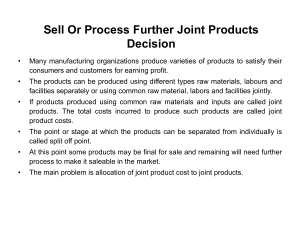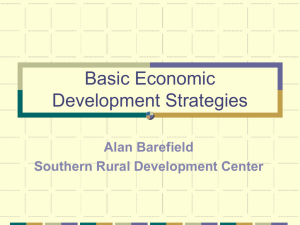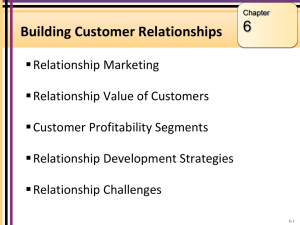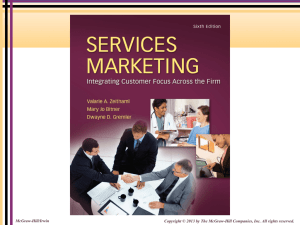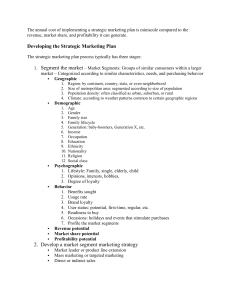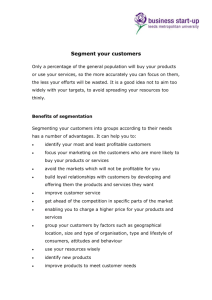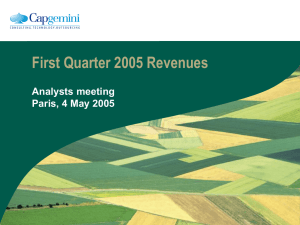Relationship Marketing Chapter 6
advertisement
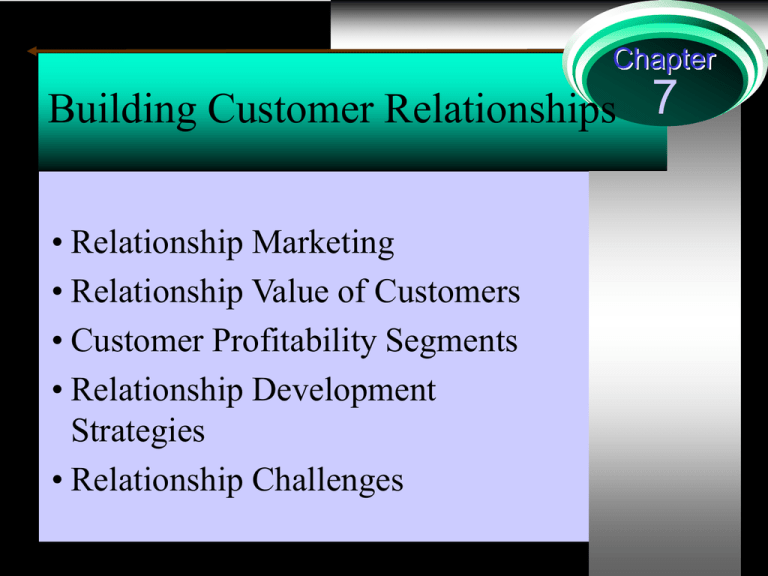
Chapter Building Customer Relationships 7 • Relationship Marketing • Relationship Value of Customers • Customer Profitability Segments • Relationship Development Strategies • Relationship Challenges Relationship Marketing • is a philosophy of doing business, a strategic orientation, that focuses on keeping current customers and improving relationships with them • does not necessarily emphasize acquiring new customers • is usually cheaper (for the firm) – keeping a current customer costs less than attracting a new one • thus, the focus is less on attraction, and more on retention and enhancement of customer relationships Provider Gap 1 When companies have strong relationships with customers gap 1 is _________________ Customer Expectations Gap 1 Company Perceptions of Consumer Expectations Benefits of Relationship Marketing • Benefits for Customers: – Receipt of greater value – Confidence benefits: • trust • confidence in provider • reduced anxiety – Social benefits: • familiarity • social support • personal relationships – Special treatment benefits: • special deals • price breaks • Benefits for Firms: – Economic benefits: • increased revenues • reduced marketing and administrative costs • regular revenue stream – Customer behavior benefits: • strong word-of-mouth endorsements • customer voluntary performance • social benefits to other customers • mentors to other customers – Human resource management benefits: • easier jobs for employees • social benefits for employees • employee retention Customer Loyalty Relational Benefits for Customers __________ benefits: feelings of trust or confidence in the provider; comfort in knowing what to expect _________ benefits: familiarity; personal relationship _________________ benefits: preferential treatment Benefits to the Organization of Customer Loyalty Economic Benefits • Increasing customer purchases - loyal customers tend to spend more with the organization over time • Lower costs - on average costs of relationship maintenance are lower than new customer costs Benefits to the Organization of Customer Loyalty Customer Behavior Benefits Human Resource Management Benefits Figure 7.3 Profit Impact of 5 Percent Increase in Retention Rate Source: F. F. Reichheld, “Loyalty and the Renaissance of Marketing,” Marketing Management, vol. 2, no. 4 (1994), p. 15. Effective Segmentation Customer Profitability Segments Not all customers are worth attracting and keeping It is neither practical nor profitable to meet (and certainly not to exceed) all customers expectations Objective: company divides target market according to current and/or future _______________ Figure 7.4 The Customer Pyramid Most Profitable Customers Platinum What segment spends more with us over time, costs less to maintain, spreads positive word of mouth? Gold Iron Lead Least Profitable Customers What segment costs us in time, effort and money yet does not provide the return we want? What segment is difficult to do business with? Art of Attracting and Keeping Profitable Customers 20-80-30 rule: Top 20 percent of customers generate 80 percent of company’s profits, half of which is lost serving the bottom 30 percent of unprofitable customers - William Sherden 1994 “The Customer Is NOT Always Right” • Not all customers are good relationship customers: – wrong segment – not profitable in the long term – difficult customers Application Build relationships with the most profitable customers; “fire” the least profitable customers

